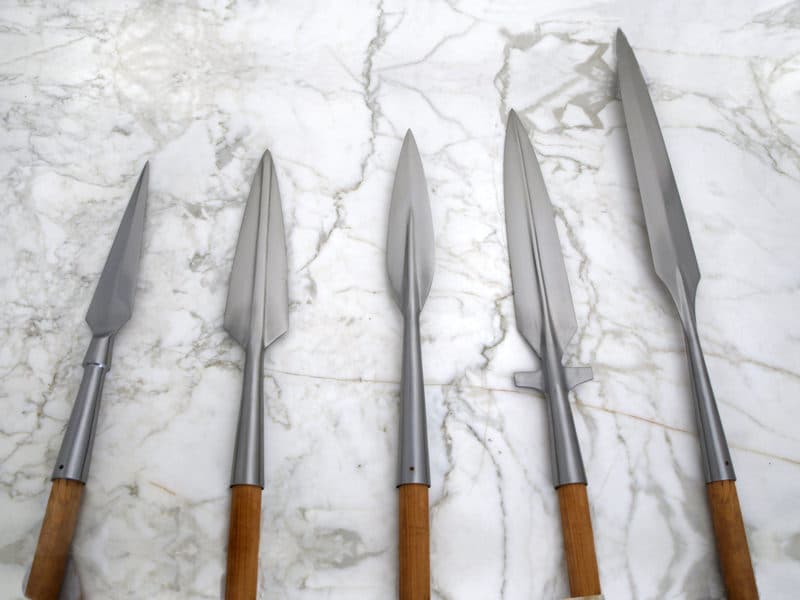Whenever Vikings are portrayed by modern media we invariably see masses of axe wielding warriors peppered by a few swordsman. We know swords were very expensive, and that axes were both brutally effective and reasonably common weapons – and tools – of any Norse warrior.
But in truth, neither axes nor swords were the kings of the battlefield.
Axes may have been common for the Viking warrior, but were neither the only one nor the most common weapon on any battlefield. That honor goes to Odin’s trusted weapon of choice, the spear.

We could arbitrarily classify spears into three different groups: one-handed spears, two-handed spears and throwing spears or javelins. The Norse spearheads also have three typology groups: Leaf shaped heads, Angular shaped heads with short sockets and Angular spearheads with long sockets. These groups are further segmented in the Pettersen spear typology, ranging from type A to type M, plus some additional types that could not fit these criteria.

Researchers believe that spears were mostly used as one-handed weapons, combined with shields. It is commonly accepted due to the hundreds of spearheads from the period that were found, that one-handed spears would have a thinner shaft, usually less than 25mm (1”) thick, while spears with thicker and longer shafts would be used two-handed, possibly with a shield slung over the warrior’s shoulder. Corroboration for this can be found in a Pictish picture stone depicting a battle and dating to somewhere between AD 700 to 850. The second image is from a European manuscript made in Switzerland dating to AD 1125-1150:

Scotland, Aberlemo stone carving c.700-850. Depicts a warrior attacking a mounted warrior.

While more robust and broader spearheads were produced for thrusting and stabbing, the narrower ones were created for throwing. Heavy thrusting spears, for example, could have been over 2 meters long, while throwing weapons would be significantly shorter. There was no standardization in the length of a spear and it would not be uncommon for warriors in the same group to have several different spears in different sizes.
To an untrained eye, a spear may not seem as dangerous as an axe or a sword. This misconception is very easy to dispel once we take into consideration the reach of the weapon, which allow its user to potentially slay the enemy before the foe has the range to strike.
The spear was also easier to make than swords or axes and significantly cheaper, as they required fewer resources. They were also and many spearheads were also brought from abroad, some imported in trade expeditions, some acquired during raids.
Throwing a spear was quite popular. The Eyrbyggja saga alludes that a customary start to a battle included throwing a spear right over the enemy army to claim favor from Odin.
A famous Viking spear is the “Viking Spear from the Lendbreen Ice Patch”, found in 1974 in Norway by a young student, Per Dagsgard.
The spear was from between 825 and 950 AD, of the Pettersen type F, and with all details amazingly preserved:

The first museum photo of the spear (C34256), probably taken 1974 or 1975.
The spear from Lendbreen has a 45.5 cm long iron spearhead. The length of the blade is 31 cm, and the largest width is 5.3 cm. The spearhead is of Jan Petersen type F, dating the spear to the period AD 825-950 and the shaft is 185cm long and made of birch.

The complete spear. The shaft is now in three pieces. It is not known why it has been broken up while at the museum, only that this happened before 1989.
Carrying weapons was not only permitted for free citizens of the north, but also encouraged. All free men were allowed to not only own weapons but were legally allowed to always have them by their side. In the Edda poem Hávamál, Odin gives advice on proper weapon behavior, in verse 38 he says:
Vápnum sínum skal-a maðr velli á
feti ganga framar,
því at óvíst er at vita,
nær verðr á vegum úti geirs of þörf guma
Let a man never stir on his road a step
without his weapons of war;
for unsure is the knowing when need shall arise
of a spear on the way without
The times have changed a lot since the Viking Age, and openly carrying a weapon is no longer socially acceptable in most places. Allfather Odin is the patron of wisdom, and we could argue that nowadays one individual could do more harm with a little technology and a lot of wits than any person with a spear – or even a gun (just imagine someone hacking a nuclear power plant).
Wisdom and quick wits are the true weapons of our age so, do not leave home without your wits. You never know when you will need them.
Sources:
Bjorn, Anathon, and Shetelig, Haakon (1940) Viking Antiquities in England. Edited by Haakon Shetelig. ISBN 13: 978-1-014-52624-3
Hewitt, John (1855) Ancient Armour and Weapons in Europe. ISBN-13: 978-1-165-93674-8
Lee M. Hollander (1962) The Poetic Edda. 15th. edition. Texas, USA: University Research Institute of the University of Texas. ISBN 978-0-292-76499-6
Jesse Byock (2005) Snorri Sturluson, The Prose Edda. 1st. edition. London, England: Penguin Books Ltd. ISBN-13 978-0-140-44755-2
Anthony Faulkes (1995) Snorri Sturluson, Edda. 3rd. edition. London, England: Everyman J. M. Dent. ISBN-13 978-0-4608-7616-2












